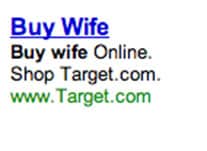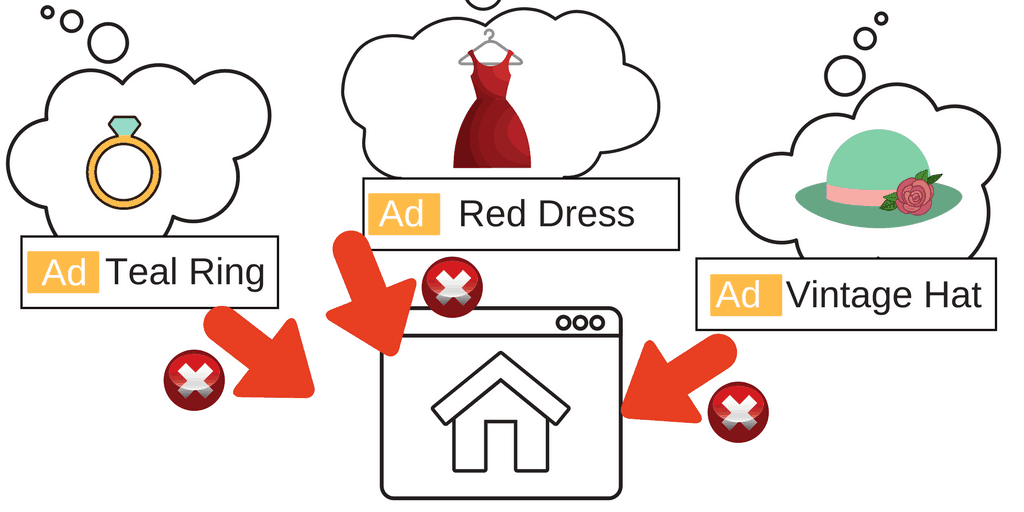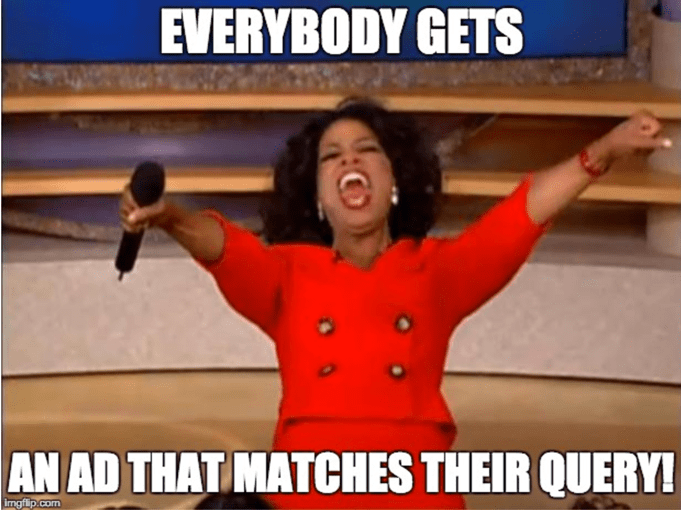How to Use Dynamic Keyword Insertion for Better Ads & UX
As search marketers, we know this to be true: dynamic keyword insertion is a sloppy, often comically-bad rookie solution.
Maybe we even attempted DKI in our past, beguiled by the promise of relevant ads without the effort. But we discovered that the careful curation of a headline could not be relegated to a keyword list and a set of curly brackets.
We grew wiser, more sophisticated. We mockingly posted screen grabs of DKI ads for used socks and dirty diapers. We blogged and tweeted our contempt for the practice.

Target, ebay, and amazon will forever be the punchline to DKI jokes, this one courtesy of White Shark Media.
Can DKI be imprecise? Of course –but so can a surgeon’s blade in untrained hands. Used correctly, DKI can be a powerful tool to solve some pesky PPC account problems and improve performance.
If the only time you use DKI these days is to get a laugh from your colleagues, read these tips to see how you can use it to:
- increase relevancy
- improve message match
- get higher CTRs and conversion rates
Preliminary DKI Myth Busting
Let’s clear something up right away: DKI uses your keywords, not the search terms typed into the search bar.
This means that if DKI injects bad spelling into your ad, you spelled your keywords wrong. Your DKI ad for dirty socks showed up because “dirty socks” is a keyword phrase you’re bidding on.
Your success in using DKI strategically and gracefully depends on your ability to curate your keywords.DKI ads do not belong in ad groups with misspelled, grammatically incorrect, or otherwise poorly constructed keywords sets.

Guess what? Dynamic Keyword Insertion isn’t spell check!
Okay, now that we’ve got that covered, let’s dig in…
DKI meets Pareto’s Principle
If you’re managing an account with a product or service catalog, you probably have PPC campaigns that neatly follow Pareto’s principle, meaning that 20% of the effort yields 80% of the results
A lot of times, you’ll focus on the 20% (smart decision), but that leaves 80% of the account (campaigns, ad groups, long-tail terms) that are under-managed at best.
Let’s say, for instance, that you manage an account for a vintage-inspired clothing site. Vintage dresses are your most popular items, so your dress campaigns are highly-optimized.
Your campaigns for swimwear, shoes, accessories, and household goods are a bit of a jumbled mess. Right now, any search on a vintage shoe keyword leads to the shoe department page, since there hasn’t been time to refine the campaign further.
How do you get better relevancy and performance without exponentially increasing ad groups and effort? Enter DKI.
Step 1: Build your themed ad groups
Let’s look at optimizing the Shoe campaign. The shoe department contains 175 popular products across4 categories: heels, flats, sandals, and wedges. Creating a dedicated ad group for each product would mean 1000s of new keywords and 350+ ads to manage–not a smart expansion.
By creating category-level ad groups and assigning product inventory keywords accordingly, you can bring the new ad groups down to 4. The ad groups will be:
- Heels DKI
- Flats DKI
- Sandals DKI
- Wedges DKI
As we’ll review later, breaking up offerings into category (or themed) ad groups will help you build highly-relevant ad copy and better manage the campaign.
Step 2: List out your product URLs
The genius behind this tip lies in your ability to set your final URLs at the keyword level rather than the ad level. After all, what good is it to have ads dynamically reflecting “red sandals” and “blue sandals” and “yellow sandals” if they’re all driving back to the same sandals category page?

Using DKI to drive visitors to anything but the exact product they’re searching for is a missed opportunity.
Don’t just use DKI to increase CTR! Follow through with a more relevant landing page to improve conversion rates.
Make a list of the product pages relevant to each of your ad groups (excel works great for this step). The URL for the “retro-style mary jane pumps” page maps to the heels ad group, and the “vegan leather ballet flats” URL is in the flats ad group.
If your product catalog is very large, I recommend focussing just on top products rather than every single listing. There’s no return on investment for products with no search volume, so work big to small.
Step 3: Create your modified broad keyword list
Now that you’ve got a list of product-level URLs, it’s time to associate them with relevant keywords. What are the core terms people will be looking for if they want to find the product featured on the page?
Using modified broad match, write out concise product names or descriptions (aim for around 25 characters or less).
Remember what we reviewed at the beginning of the article – you’ve got to curate your keywords by being strategic and intentional in how you write them. The keywords in these ad groups will be feeding DKI ads, so they must be grammatically correct, and order matters.
+teal +wingtip +pumps is good since it makes sense as a phrase in an ad.
+wingtip +pumps +teal is bad since it’s awkwardly worded.
Finally, only put a “+” in front of the core terms.
If the product name is “bird and the jukebox heels”, write the keyword as:
+bird and the +jukebox +heels
This way someone could type “bird jukebox heels” and still see your ad, but your product name will be displayed accurately & correctly even when DKI is in use.
You can match multiple keyword phrases to each URL. Remember the law of diminishing returns here. Modified broad casts a wonderfully wide net, and longtail keyword phrases beyond 25-28 characters will not be featured in a DKI headlines (see Step 4).
Step 4: Create theme-specific ads with a DKI headline
Since all your ad groups contain similar products and offerings, your ad descriptions should be very relevant to each category. Here’s a basic outline of how this will be structured:
Headline: Specific Product
Description 1: Category Description
Description 2: Category / Brand Description
Once it’s filled in, the ad will look like this:
Teal Wingtip Pumps
Classy vintage-style pumps & heels.
Go retro & turn heads. Get 15% off!
Not bad for a DKI ad, right?

For each ad group, you’ll write a new category description specific to your products in Line 1. Whether you recycle description 2 or keep it unique is up to you and how you structure your ads.
To get DKI in the headline, you’ll need to specify a few things:
- How should the casing be handled?
- What should the default headline be if the keyword phrase is longer than 25 characters?
You tell AdWords how you’d like casing to appear in your ad by how you capitalize the word “keyword” that appears before your default headline. You’ll probably want to use either:
- Sentence case: (Teal wingtip pumps). Use: {Keyword: …}
- Title case: (Teal Wingtip Pumps). Use: {KeyWord: …}
Lower case and all caps options can be found in this Google support article. https://support.google.com/adwords/answer/2454041?hl=en
Your default headline shows up when your keyword is too long to be used as a headline.
- +poppy print +wedges (18 characters) can safely fit in a headline with DKI.
- red +poppy print +wedges size 7 clearance (39 characters) cannot, so a default must be used.
Because DKI is the point of this exercise, aim for shorter keyword phrases.
Enter your default headline directly after the colon in the curly brackets {Keyword: Default headline}. The headline should be something that relates to your ad group theme but doesn’t just repeat your description. For this ad, I’d go with:
{KeyWord:Vintage Fashion Heels}
A major benefit of having an ad that closely reflects the query (and thus, a benefit of DKI) is that matching terms in your ad get bolded, drawing the attention of the searcher and increasing the likelihood of a click. Try to include core and common terms from your ad group in your default headline for best relevancy.
You can also append your headline with certain terms. If, for instance, you were only bidding on proper names of products which don’t include a descriptive term, you can modify your headline to include your category:
Keyword: +Beehive +2pm
DKI Headline: {KeyWord: Vintage Fashion} Heels
The key is consistency; if you’re going to modify your ad, be sure it makes sense for all the keywords in your ad group.
Pro-tip: DKI can extend character limits
As long as your keywords are all around 25 characters, your keywords will always trump your default headline contained in the curly brackets. In fact, AdWords will sometimes include your keywords in a DKI headline even when the character count exceeds 25.
When I’ve had important core keywords that are longer than 25 characters, I’ve created single keyword ad groups (SKAGs) with DKI just to extend the character length of the headline. In my experience, this has driven a higher CTR, and it creates an ad that better matches the offer and the intent of the search.

Putting it all together
With your tightly-themed ad groups, curated keyword lists, keyword-level final URLs, and highly-relevant ad copy, your execution of DKI should be nearly flawless.
Your lists will be easy to manage, your visitor will quickly reach a page that matches the query, and you should see much higher CTRs and conversion rates.
Be sure to continue to optimize your ad groups. You may find that some modified broad terms are just too broad, and phrase or exact matches are best. You may also find that this highly relevant click path results in new top performers which can be broken out into new ad groups and campaigns for better control.

Using a smart approach to DKI not only saves you time and increases relevancy and revenue, it also can give you additional insights to your account, and can help you better identify areas of opportunities.
Are you serious about getting better at paid search? Learn more about PPC Coaching with Amy here.
If you feel the same way, join us here. You'll get our latest content and podcast episodes that will teach, inspire, and motivate you to achieve new levels of success with Paid Search.Here at Paid Search Magic, we get pretty excited about all things related to getting better RESULTS in Paid Search Marketing.

